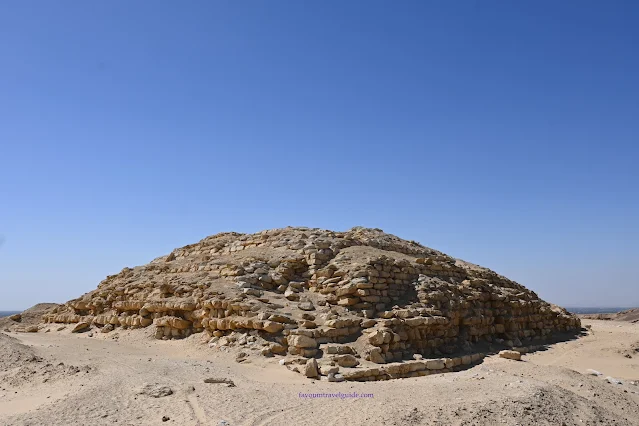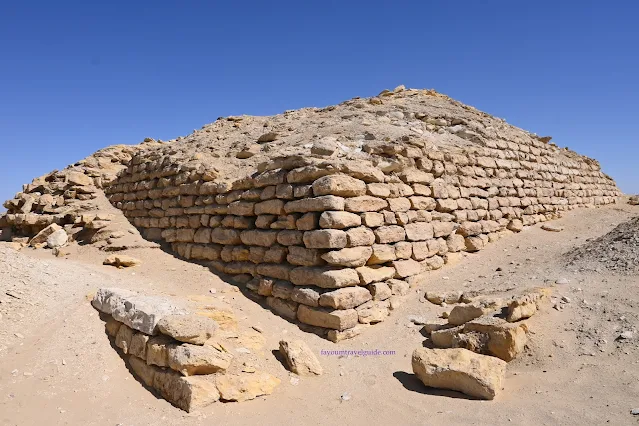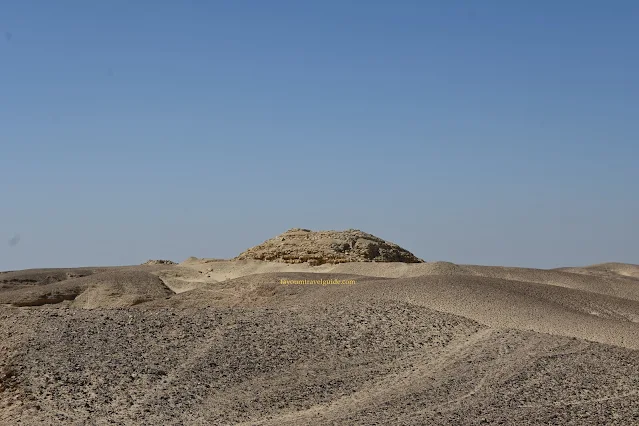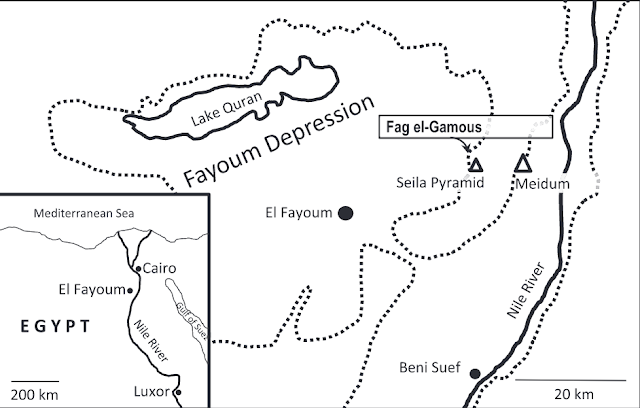Seila Pyramid was built by Snefru. The discovery of this pyramid and the identification of its owner has been part of what has caused some to believe that the Fayoum was of greater importance during the Old Kingdom than was originally thought. Additionally, Grenfell and Hunt found a small Old Kingdom cemetery near the village of Seila (not far from the pyramid), and two small Old Kingdom statues were found near the pyramid, or perhaps in the cemetery.
Yoyotte postulated that the area near Seila had become an important administrative mirror to the Meidum area.Dreyer and Kaiser concluded that it had become a seat of royal power and administration. They were followed in this conclusion by Stadelmann and then Ćwiek.
Ćwiek later argued that Seila may have been the administrative capital of the Fayoum at the time that region was growing in population and importance.
Ćwiek later argued that Seila may have been the administrative capital of the Fayoum at the time that region was growing in population and importance.
The substantial population center at Seila would have helped supply the manpower for building both the Meidum and Seila Pyramids, which are 10 km apart. He also suggests that the shape and location of the Meidum cemetery indicate a close connection with the nearby Gerza cemetery (in the Fayoum), because they stretch towards each other. The Gerza cemetery was in turn associated with an old and traditional trade route that connected the Nile Valley to the Fayoum. This road runs right through the Fag el-Gamous cemetery and just below the Seila Pyramid, coming almost to the town of Seila (it may have come to it in earlier eras).
The geography of the area dictates that the Seila area would have been an important part of the Fayoum. It is on the eastern-most edge of the Fayoum, meaning that it is closer to the Nile Valley than anywhere else in the Fayoum. Any road that cut across the desert from the Nile Valley in this eastern-most area would have run into the Gebel el-Rus ridge, whose extremely steep hills would have barred passage. The ridge suddenly ends just north of Seila, at the exact place the canal bends towards the east for a short distance. This is exactly where a road coming from the Nile Valley area of Meidum would enter the Fayoum, making this road the most direct route between the fertile depression and the concentration of population and culture that was next to the Nile. The Seila Pyramid sits at the southern and eastern end of the ridge, looking down on where the ancient road would have run and intersected with the canal. The need for transportation and trade, the ability to guard the way in and out of the Fayoum, and the ability to control and tax trade at such a transportation bottleneck, almost demanded that the Seila area become an important center. In many ways the Seila area was the gateway to the Fayoum, and the pyramid sat astride that entrance.
Seila seems to have become something of a population center in the Old Kingdom, and would be part of why the Seila Pyramid would have been built there, though surely there were other reasons as well. The inhabitants of Seila would have been able to support the cultic functions of the pyramid,78 though the priests themselves may have lived in the foothills near the pyramid rather than in the village itself. 79 This depends somewhat on the frequency of the rituals that were performed at the pyramid.
The town of Seila seems to have been substantial during the Fourth Dynasty, being large enough to support the building and maintenance of a pyramid and its cult, and that it certainly received royal attention and visits, with perhaps a royal residence being constructed there.
The history of the Fayoum during the Old Kingdom, particularly in the Fourth Dynasty. Further studies of cemeteries, titles and histories from the Old Kingdom, archaeological work in places such as Seila, and administrative texts are necessary to better flesh out the roles and activities of the Fayoum during this era. It is also clear that the Seila pyramid both informs and is informed by our understanding of the Fayoum and Meidum areas during this era.
Seila lies due east of the southern edge of the cemetery, and further south lies Bandiq. Somewhere close to these sites, but with a location not fully identified,was Alabanthis. Even further south is Hawara. Not far to the north is Philadelphia with Roda and Farqus further to the west .
The Zenon papyri reveal the workings of a different very large estate that oversaw considerable lands and the construction of many buildings. As part of this it was also involved in creating canal and irrigation systems and dykes. The estate included a palatial house, a court, gardens, stables for cattle, store-houses, space for servants and employees, wine cellars, baths, and more. It probably also included elements other estates in the city had, such as olive and wine presses, stables for horses, a bakery, and a large kitchen. Its holdings included goats, horses, cattle, and the growing of olives, grain, sesame, nut trees, and vineyards.
The surface ruins of Philadelphia contain a number of visible granite and basalt features, indicating a degree of prosperity in the city. Based on a surface survey of pottery, and a brief initial comparison of pottery from the various parts of the city, the area near the canal seems to have been a wealthier area than other parts of the city. The city also seems to have contained industrial elements, as indicated by what seem to be the remains of a lime smelting kiln. In other words, Philadelphia was a city of inhabitants from a variety of cultures, classes, and vocations. This diverse group of people potentially represent a range of possible inhabitants of the Fag el-Gamous cemetery.
Philadelphia, Tanis, and all the surrounding area went into decline in the 4th and 5th centuries AD, and largely disappear in the 7th and 8th centuries. At least some of the reason for this decline was likely the silting up and other damage to the Bahr Seila, which was the agricultural lifeblood for the communities of the northeast Fayoum. Still, no one fully understands the reasons for the steady shrinking of the Fayoum economy and population. Unsurprisingly, the Fag el Gamous cemetery discontinues at about the same time as the nearby villages and towns also fell out of use. As the villages passed from use they also passed from history. Their stories lie largely untold, buried beneath the sand of the cities and cemeteries.






No comments:
Post a Comment